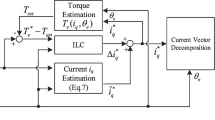Abstract
Basic concepts for the vector theory of an induction motor are proposed. The vector method is used to derive new systems of equations and limits for torques, phase angles and absolute values of currents, and the flux linkage for nonlinear saturation. The theory, which is confirmed by the experiment, may be used for the system optimization of induction motors and asynchronous electric drives based on the energy performance criteria.
Similar content being viewed by others
References
Mishchenko, V.A., A Vector Method for Control of Electromechanic Converters, Elektrotekhnika, 2004, no. 7, pp. 47–51.
Mishchenko, V.A., Teoriya, sposoby i sistemy vektornogo i optimal’nogo vektornogo upravleniya electroprivodami peremennogo toka (Theory, Methods, and Systems for Vector and Optimal Vector Control of AC Electric Drives), Moscow, 2002.
Polkovnikov, V.A., Elektricheskie, gidravlicheskie i pnevmaticheskie privody letatel’nylh apparatov i ikh predel’nye dinamicheskie vozmozhnosti (Electric, Hydraulic, and Pneumatic Aircraft Drives and their Limiting Dynamic Capacities), Moscow: Izd. MAI, 2002.
Author information
Authors and Affiliations
Additional information
Original Russian Text © V.A. Mishchenko, 2007, published in Elektrotekhnika, 2007, No. 6, pp. 5–12.
About this article
Cite this article
Mishchenko, V.A. Vector theory of an induction motor. Russ. Electr. Engin. 78, 280–286 (2007). https://doi.org/10.3103/S1068371207060028
Issue Date:
DOI: https://doi.org/10.3103/S1068371207060028




